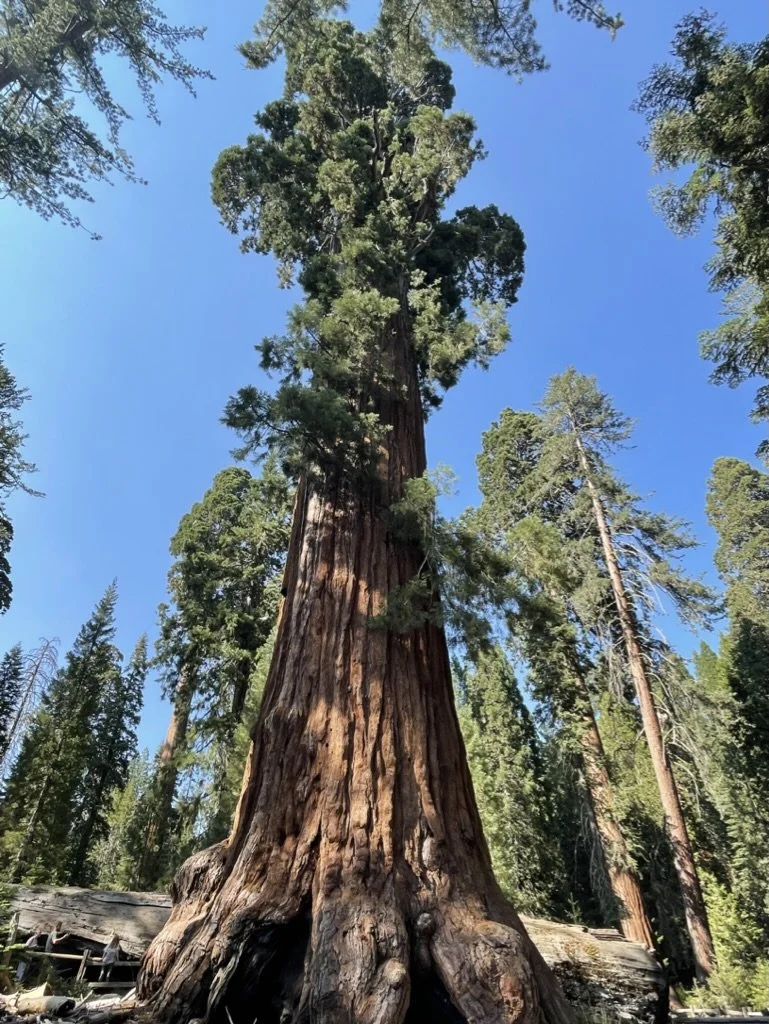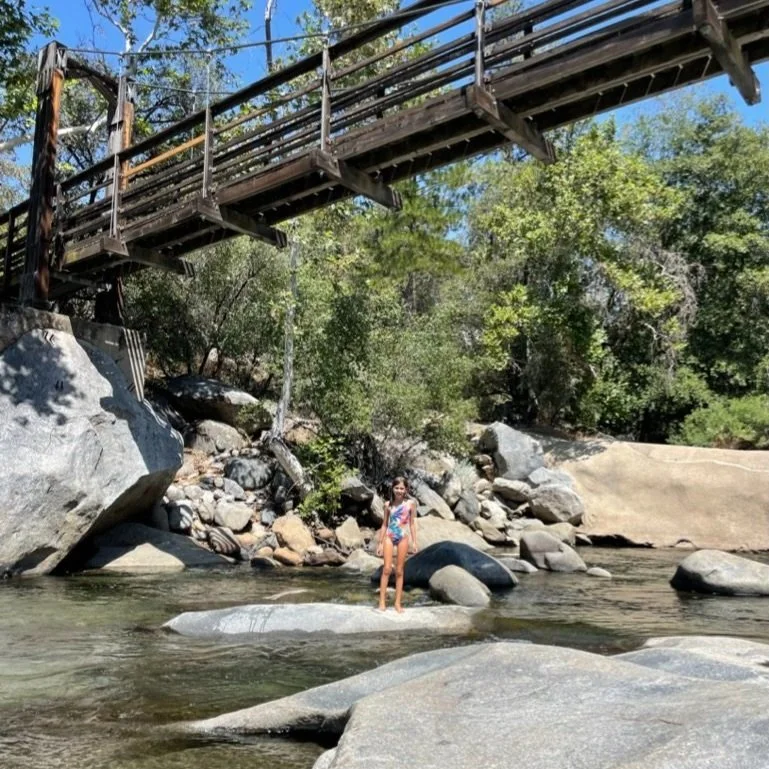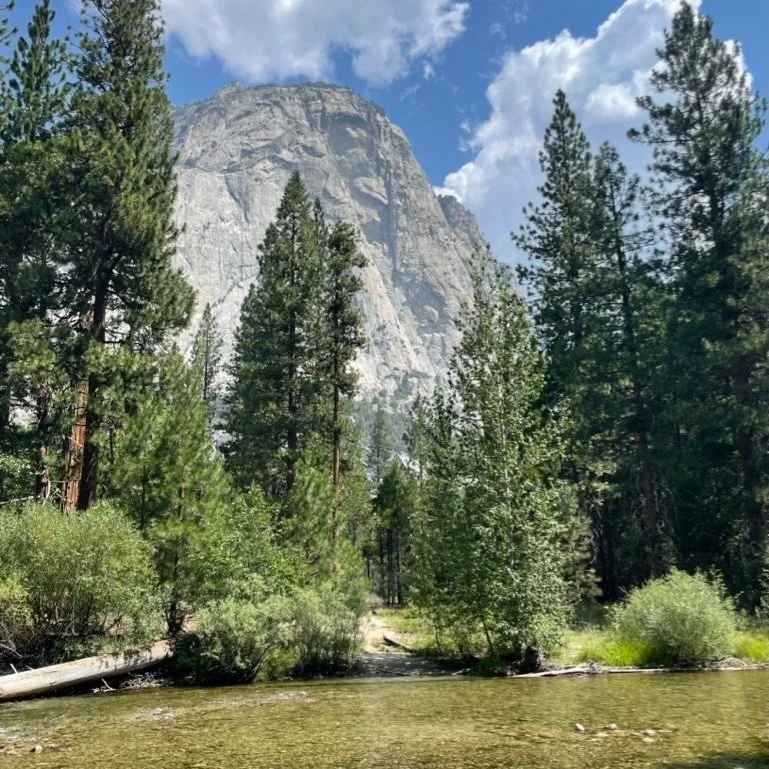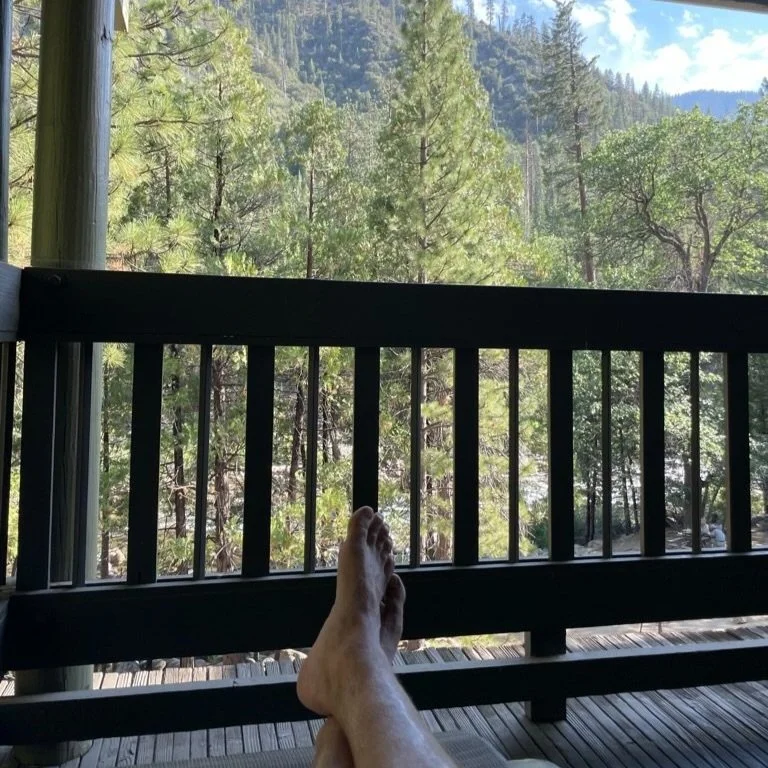Sequoia & Kings Canyon National Parks
Two parks for the price of one! Sequoia and Kings Canyon are often seen as the little brother of Yosemite or the “other” Sierra Nevada parks. But they stand on their own in many ways and deserve the time and exploration.
After escaping the smoke pouring into Yosemite Valley, we headed south looking for more fresh air and fun activities. We entered through the Big Stump entrance and started with the Big Stump Trail, which lives up to its name sake. We’d seen Giant Sequoias in Yosemite and so many Coastal Redwoods in Redwoods, but if these stumps were any indication, we hadn’t seen anything yet.
In Grant Village we dropped into the Kings Canyon Visitor Center. This feels like the right time to explain the difference between the two parks. The quick answer is that you can treat them as one park, as they are contiguous, share Park Rangers, and you only get one Junior Ranger badge. But they do have a somewhat separate history.
Sequoia National Park was established in 1890, making it the second national park in the U.S., after Yellowstone. Its purpose was to protect the towering giant sequoias in the Giant Forest, including the General Sherman Tree, the largest tree on Earth by volume. It was one of our country’s earliest attempts to preserve a specific ecosystem before logging could claim it all. That same year, Congress also created a small park nearby to protect the General Grant Tree and a handful of surrounding sequoias. They called it General Grant National Park.
In the 1930s, conservationists advocated to protect the spectacular glacier-carved Kings Canyon. In 1940 that the area was added to the national park system as Kings Canyon National Park. With sweeping granite walls, glacial valleys, and roaring rivers, Kings Canyon rivals Yosemite in beauty—and it took the advocacy of folks like John Muir and Ansel Adams to make sure it got the protection it deserved. When the Park was officially created, it absorbed the older General Grant Park.
Even though Sequoia and Kings Canyon were established 50 years apart, they’ve been jointly administered since 1943. On paper, they’re still two parks. But in practice, they function as one—sharing a border, a mission, and a sense of awe that you feel the moment you step into their wilderness.
As a result of the creation saga, the portion of Kings Canyon NP that used to be General Grant National Park—now referred to Grant Village—actually abuts the northwest corner of Sequoia and doens’t touch the rest of Kings Canyon. And as you drive around, you’ll find yourself driving in and out of the Parks, as well as Sequoia National Forest, Giant Sequoia National Monument, the John Krebs Wilderness, and other designated, protected areas. Grant Village ends up serving as the center point for both Parks and has the majority of the services and even cell service!
While in Grant Village we visited General Grant, and saw numerous other behemoths, before bedding down at Stoney Creek campground. We ended up here because it was easier to book a USFS campground six months out, as the NPS-run campgrounds were still not accepting reservations after the previous year’s KNP Complex fire, which burned 88 thousand acres, including four thousand acres of Sequoia habitat. Evidence of the fire was everywhere we drove in Sequoia.
On day two in SEKI, we headed south to explore the Giant Forest Museum and hiked the Tall Trees Trail. We hopped on the shuttle toward General Sherman, which was quite crowded. We were glad to see it standing unharmed after the KNP fire, which was a real threat.
We kept driving through, essentially the only road in Sequoia, toward the Foothills Visitor Center. If you think you can’t find traffic in the middle of the forest, try a summer drive down the Generals Highway. The combination of construction and visitors made it slow going, but that’s just more time to enjoy the surroundings.
Bear in mind, we came down from the Lodgepole area, which is 6,700’ in elevation to Foothills, which is about 2,500’. So it’s a lot of brake riding and switchbacks. It’s am amazing drive.
A quick stop in the visitor center, and we were off to follow a tip we’d been given a couple weeks before. There’s a semi-secret swimming hole near Potiwash. Park across main road from the campground in a big gravel lot near the the dump station. Follow the trail back with the stream on your right until you find a man-made bridge (can’t miss it). Below that bridge is a series of rock outcroppings and cascades that may qualify as the best place we’ve ever swam at a national park (and that’s tough competition given we’ve swam in every park this year except for Redwood).
A couple hours here enjoying the natural water slides, and we drove back to the Giant Forest (after failing to find parking at Buckeye Flats). We took the 350 steps up to Moro Rock for an amazing view in all directions, stopped at the infamous Auto Log (which you can’t drive through, because it fell), and then drove through the iconic Tunnel Log and got some great photos. We were on our way to Crescent Meadows.
We’d gotten a tips from a ranger in Lodgepole that we would have a good chance of seeing black bears in Crescent Meadow. We hiked to Log Meadow, and then on our way to Tharps Log, we saw a dark colored black bear. Soon, we discovers another lighter brown black bear with a cubs, which was delightful. He kept bouncing and bounding and standing—just barely taller than the grass. We must have watched for 45 minutes. The wildlife activity may have made Tharp’s Log anti-climatic, but we were glad to make it there, and we certainly earned our pizza dinner in Wuksachi.
On day three, we called a major audible. We dialed up Grant Stables from the parking lot of our hike (the first time we had service) and booked a two-hour ride for the same day. We just enough time to complete the two mile hike at Buena Vista before heading off to ride. Buena Vista does live up to it’s name, even if a significant portion of the view is of charred trees from the KNP fire.
The two-hour ride was our first time on horse back on this year's trip, and well worth it. We took routes through the Grant Grove that were too far for us to hike on the previous day. We saw the Fallen Monarch, trees named after states, and learned a lot about forest management and the role of fire. After that, we snagged that Junior Ranger badge and headed back to camp to read in our hammocks.
The next morning we were off to King Canyon (the geographical feature and the majority of the park that we had yet to see). Again, we left the park, drove through the national forest, and dropped about 2,000’ from Grant Village to Cedar Grove Visitor Center. We chatted with some Rangers and were amazed at how rustic and backwoods these part of the part felt, if only because it’s hard to get supplied down into the canyon.
We filled out the day by taking a Ranger-led hike is Zumwalt Meadow—with some post hike exploring, visiting Roaring River Falls, checking into Cedar Grove Lodge, and swimming in the river nearby. Showers and couple nights out of the van were welcome.
Any early wake up on day four, and we were off for our adventurous journey for this park. Fueled by a complementary breakfast at the Lodge, we took on Mist Falls. This 9.4-mile round trip hike departs from the aptly names Roads End parking area and had us brushing shoulders with backpackers. This area gave us a better idea of what trekking in the High Sierra’s might be like (though we didn’t get that high). The mosquitoes are terrible, the rattlesnakes are plenty (we saw three), and the forest is miraculously beautiful. Mist Falls (not to be confused with the one in Yosemite) is a series of falls and pools that is truly drops the jaw. We even found some safe spots to dip in the water.
We got done just after lunch and spend the rest of the afternoon swimming in the river, reading on lodge’s lounge chairs, and enjoying some ice cream. We had dinner at the grill, and we have to say that we appreciate every piece of furniture and food that is brought down to this remote area. The services and the peace and quiet juxtapose very well for us.
On the way out of Kings Canyon we pulled over for some vistas we had'n’t hit on the way down. We ventured to Hume Lake in the national forest to check out Sandy Cove and some other beach areas. We dipped our toes and explored amongst the many people who were enjoying this mountain lake.
And then we were off to Fresno for a laundramat, groceries, and dinner. In n Out here we come!











